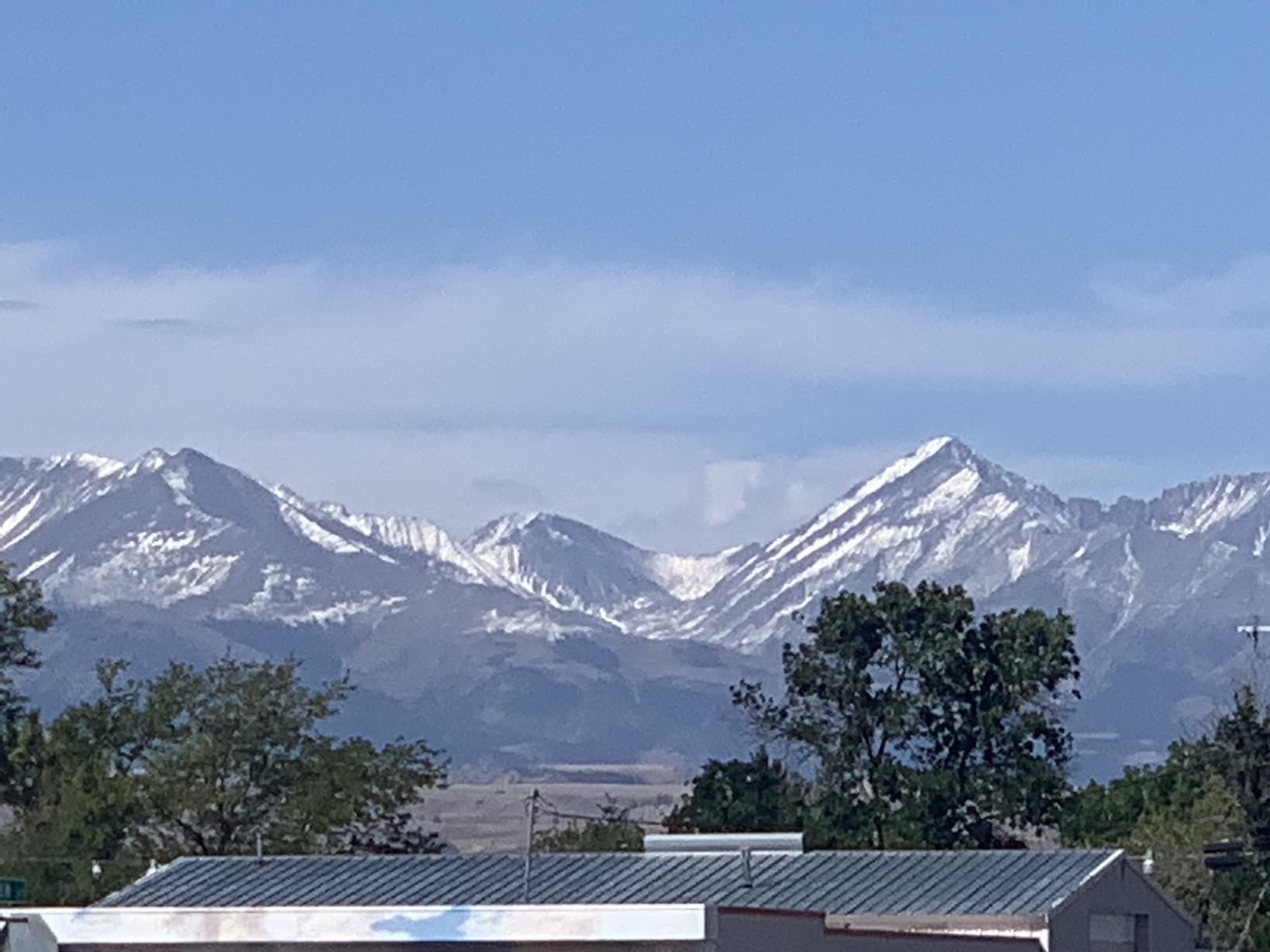Changing seasons
23/09/22 23:51

The Crazy Mountains viewed from Big Timber, Montana. The roof in the foreground is of the shop where our father had his John Deere dealership.
When it was light enough to see yesterday morning, we noticed that there was snow in the high country. This is not at all unusual for September. The Crazy Mountains, rising to the north and west of my home town, have always been dramatic. When I was growing up there were summers when snow remained in high valleys year round. In recent years, however, the snow has all melted and it is common for the mountains to be free of snow from mid-June into October. The lack of snow in the high country has changed the nature of hunting season and some years has impacted the amount of water available for irrigation in some places.
Yesterday it was a simple reminder that fall is coming. Two years ago, when we made our move from South Dakota to Washington, we were hung up for a couple of days in the same cabin where we are staying now. It was a bit later in the year - mid October - and we still had one more trip to make from South Dakota to Washington. We were set to close on the sale of our South Dakota home and had a few more things to pick up for the final trip of our move. We were eager to get back to South Dakota to finish our chores there, which included some cleaning of our home. However, we simply had to sit and wait out the weather as a couple of feet of snow rendered the roads impassable and our patience was required as we waited out the storm.
There was one thing I noticed from that trip that informed this one. The prevailing wind in Montana blows from West to East, so driving across the state usually means a headwind when heading west and a tailwind when heading east. On that trip ahead of the snow storm two years ago, and on this trip, as we drove across western Montana, we were driving into a headwind. I joked about making a trip where I would be driving into the wind both ways, and recalled similar trips across South Dakota. When the wind is blowing out of the east, it means that there is a low pressure system behind us. In other words, a storm is blowing in.
On this trip, however, the storm brought only a few raindrops to the lowlands. Our cabin here is at about 4500 feet above sea level and we saw only a few sprinkles. However, the tops of the mountains were high enough to cause precipitation from the passing clouds. I’m guessing that the snow line was around 7500 feet, based on the height of the mountains and the change in elevation.
Summers are short in the high country. It is part of what makes a visit to the high places so exciting. Around the middle of June, daytime temperatures rise high enough that the snow melts. The days are long and the nights are short. Wildflowers bloom in profusion in the short season. The animals move up into the high country and feast on the fresh grasses that grow in the short summer season.
There are other signs of the approach of autumn around here. The cottonwood trees haven’t turned color and shed their leaves yet, but they are a bit paler than their mid-summer color. The willows dance in the wind, but also are keeping their leaves for now. The deer, however, are acting as if the rut is about to begin. The young bucks are testing themselves with short head-butting clashes and a lot of strutting and prancing around. For now the does are mostly ignoring them and occasionally running them off, but you can tell by watching the deer that things will be picking up soon. The bear is eating as much as possible to pack on the pounds before heading for the hibernation den. We haven’t gotten a good enough look at the one that is going through our place, so we don’t know if it is male or female. If it is female, she probably found a male bear and mated during the summer. The embryos are inside of her, waiting until she hibernates to begin growing and developing. She needs to pack on lots of extra fat to develop cubs without eating herself.
I haven’t noticed the bats flying around in the evening. There has been enough chill to decrease the number of insects in the air. The forecast calls for more warm days and it is possible that the bugs will still be flying for a few more weeks. I saw a small garter snake trying to get some sun on the driveway yesterday afternoon, but in the late afternoon it had become so chilled that it was immobile and lethargic. It didn’t even move when I touched it. I picked it up and moved it out of the driveway so it wouldn’t get run over, but it didn’t respond at all. Hopefully it will warm when the sun comes out today and be able to return to the den before it gets so cold that it cannot move once again.
Today we will head up to Red Lodge, about a thousand feet higher than where we currently are. We’ll get a chance to look at the devastation of the late spring and early summer floods that washed out roadways and flooded basements. This has been a year of weather extremes for this part of the world.
I grew up being aware of the weather among people who talk about the weather a lot. The changing of seasons is always dramatic in this part of the world where summer highs reach above 100 degrees Fahrenheit, and winter lows can reach twenty or thirty degrees below zero.
We, however, no longer live in this place. We’re just here for a few days’ visit. Soon we’ll be on the road, heading west. We’ll probably be driving into the wind as we approach and summit the mountain passes that carry us back over the continental divide to the place we now call home where the weather is a bit less extreme. Still, we’ll notice the changing of seasons in our new home and probably tell our grandchildren a few stories about how it is in other places we have called home.
